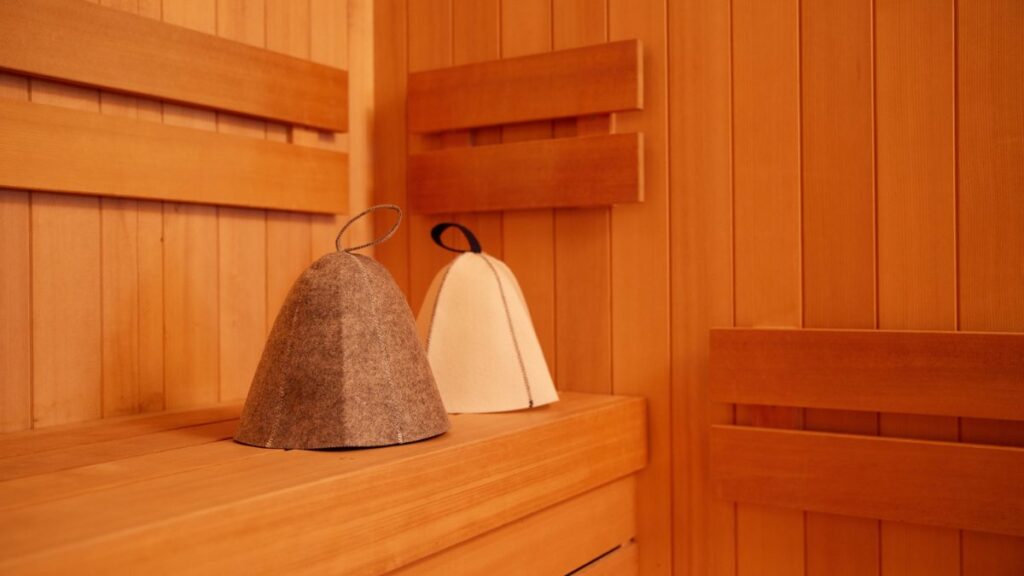How Long To See Benefits Of Infrared Sauna?

Last Updated on August 11, 2025
Ever stepped out of an infrared sauna and thought, “Shouldn’t I be feeling something by now?”
Most people expect dramatic changes after one or two sessions, but that’s not exactly how it works.
How long to see benefits of infrared sauna depends on what you’re looking to improve, whether it’s pain, inflammation, stress, sleep, or skin health.
Some effects kick in surprisingly fast. Others need time, repetition, and patience. And being a wellness and recovery consultant, this is what I recommend to my clients
Let’s break down exactly what to expect, and when.
How Soon Can You Expect Infrared Sauna Results?

Some changes are subtle. Others are surprisingly immediate. Here’s the thing: your body doesn’t need weeks to start benefiting, but it does need consistency to sustain and compound those results.
In one 2022 randomized trial, participants with chronic fatigue who used infrared sauna therapy twice a week reported significant improvement in mood and energy within just 2 weeks.
Another study published in Annals of Clinical Research showed measurable decreases in pain and stiffness in just 4 sessions.
Still, not every benefit shows up on a schedule.
Sauna recovery timelines vary, depending on your age, health status, hydration level, and how often you’re using it. That’s why your neighbor might rave about skin improvements in week one, while you’re still waiting to break a sweat.
So what can you expect, realistically?
Feel nothing yet? Let’s talk about that.
- Relaxation, better sleep, and mental clarity often arrive first, sometimes even after session one.
- Joint relief, improved circulation, and reduced inflammation typically begin in weeks 1–3.
- Deep detoxification, immune system regulation, and skin renewal may take 4–8 weeks or more.
Want faster results? Let’s dig into how to actually feel the shifts, starting now.
Immediate Benefits After The First Session
Yes, you can feel different after just one sauna session. That “melting” sensation? It’s your nervous system shifting from fight-or-flight to parasympathetic calm. Blood vessels dilate, muscles loosen, and stress hormones begin to settle down.
A 2024 review highlighted how infrared heat exposure increases beta-endorphin levels, which not only reduce stress but also help the body regulate sleep and mood. This explains why some people sleep like a baby that very night.
Now here’s where it gets real: not everyone sweats buckets the first time. And that’s okay. Sweat isn’t the only sign it’s working.
Some users notice:
- Deeper breathing and mental clarity
- More flexibility in stiff joints
- Tingling or warming sensation in old injury sites
- A noticeable “mood shift” that feels hard to explain
One session in. Now what?
If you’re thinking, “I didn’t sweat, so maybe it didn’t work,” hold that thought. The real transformation starts from the inside, and it’s already underway.
Weekly Use – What 2 To 3 Sessions A Week Can Do
Let’s say you’re showing up two to three times a week. Is that enough to feel something? Short answer, yes. Especially if you stick with it.
In fact, one study from the Experimental Gerontology showed that 3 weekly sessions of 30 minutes in an infrared sauna led to lowered blood pressure, better vascular function, and reduced oxidative stress in as little as 10 days. That’s barely over a week.
- By week two or three, most people report:
- Less muscle soreness after workouts or long workdays
- More consistent energy throughout the day
- Improved digestion or reduced bloating
- Better sleep onset and fewer nighttime wakeups
You might also notice a subtle but powerful shift in your mood stability and ability to cope with stress. That’s because regular infrared therapy lowers cortisol, boosts dopamine, and can improve heart rate variability (HRV), a key marker for nervous system health.
| What if I use it twice a week, will it still help? Absolutely. As long as you’re consistent and staying hydrated, even two sessions a week can change how your body feels, sleeps, and recovers. |
If you are a beginner and can’t figure out the duration, read my article on how long should you sit in a sauna. Plus, I do have a detailed guide on infrared sauna tips for beginners, which is worth reading.
Long-Term Infrared Sauna Benefits (4–8 Weeks Out)
By now, you’ve probably noticed a pattern—infrared sauna benefits build over time. But here’s where things start to feel different. Between weeks 4 and 8, many people hit what we call the “deep transformation stage.”
At this point, it’s no longer just about feeling good after a session. You start seeing real, lasting changes in how your body functions daily.
While the exact timeline varies from person to person, a systematic review found that regular sauna use is linked to a range of benefits, including improved cardiovascular function, lower blood pressure, reduced inflammation, and enhanced skin health, especially when sessions are consistent over time.
Four weeks in, and finally feeling it?
If you’ve been dealing with chronic pain, skin issues, autoimmune flare-ups, or fatigue, this is often when the shift becomes undeniable. Some of the deeper benefits people report after 4–8 weeks include:
- Chronic pain relief, especially in joints and muscles
- Reduction in inflammatory flare-ups like eczema, psoriasis, or arthritis
- Healthier, brighter skin tone due to increased blood flow and collagen support
- Stronger immune function, as lymphatic drainage improves and oxidative stress decreases
- Enhanced workout recovery and better exercise endurance
What this really means is that your body isn’t just responding to heat, it’s rebuilding resilience at a cellular level.
Mitochondria (your energy factories) become more efficient. Detox pathways work better. Hormones start to stabilize. All of that takes time, but it’s absolutely worth the wait.
Important:
If you have an acne problem or any sort of skin issues, consult your doctor or read my blog on will a sauna help acne before the heat hits you.
Factors That Affect How Fast You See Results

Here’s the truth: two people can use the same sauna the same way, and get completely different results. Why? Because your body’s starting point matters.
Let’s break it down. Your hydration status, nutrition, sleep habits, and even gut health play a role in how your body responds to infrared heat. If you’re chronically stressed, running on low sleep, or not drinking enough water, your results may feel sluggish, or uneven.
A quick question, is something blocking your progress?
Possibly, but the good news is, you can fix it.
Some of the most common factors that affect how fast you see benefits include:
- Frequency of use: 1 session a week won’t deliver the same effects as 3 to 5.
- Session duration: Staying in for at least 25–30 minutes allows for deeper vasodilation and detox.
- Water and mineral balance: If you’re not drinking electrolytes or rehydrating properly, your body may struggle to keep up.
- Underlying health conditions: Chronic inflammation, autoimmune disorders, or adrenal dysfunction can delay results, but often improve with steady use.
- Body fat percentage: Fat stores toxins. It may take longer to release them if your system is already burdened.
Want to optimize results? Start each session well-hydrated, take a mineral-rich drink post-sauna (like coconut water with sea salt), and stack your sessions with gentle breathwork or cold rinses. These small tweaks compound quickly.
It’s not just the sauna. It’s what you do before and after.
Read Also: Should You Sauna Before Or After A Workout?
What If You Don’t Feel Anything? When To Worry (And When Not To)
It’s one of the most common concerns I hear from clients: “I’ve used the sauna three times, and I’m not sweating. Am I doing something wrong?”
Let’s get this out of the way, not sweating doesn’t mean it’s not working. In fact, many people need a few sessions just to “train” their body to sweat more efficiently.
Your detox pathways, sweat glands, and cardiovascular system need time to adapt. And if you’re newer to wellness routines, recovering from burnout, or prone to dehydration, your system
No sweat, literally?
Now, if you’ve been using an infrared sauna consistently for over a month and feel zero changes, no better sleep, no energy shift, no reduction in tension, then it’s time to troubleshoot.
Ask yourself:
- Is the sauna temperature high enough (between 120°F and 150°F for infrared)?
- Are you staying in long enough to trigger the benefits?
- Are you feeling safe and relaxed, or tense and anxious during sessions?
- Are you pairing it with enough hydration, rest, and proper nutrition?
Still unsure? That’s where a wellness consultation can help. We can adjust your routine, recommend supportive therapies, or rule out underlying issues that might be in the way.
Remember, not all progress is loud. Sometimes it shows up as a quieter nervous system, deeper breath, or one less moment of anxiety before bed. That still counts, and it’s worth building on.
Read Also: Infrared Vs. Traditional Sauna
How To Track Progress? Signs The Infrared Sauna Is Working!
Sometimes, the benefits of infrared sauna therapy don’t scream, they whisper. And if you’re not paying attention, it’s easy to miss the clues that your body is actually thriving from the inside out.
Here’s what to look for:
Subtle Signs of Progress:
- Waking up with more energy, without dragging yourself out of bed
- Shorter recovery time after workouts or muscle strain
- Fewer sugar or caffeine cravings, thanks to improved hormonal balance
- More regular bowel movements, a huge detox cue
- Fewer headaches or brain fog episodes
- Feeling calmer overall, even in situations that used to spike your stress
If your stress response is softer, your sauna is doing its job.
One of my clients recently told me, “I didn’t even notice at first, but I realized I haven’t had a migraine in over three weeks.” That’s the kind of progress we love. It may not be flashy, but it’s deeply restorative.
If you’re someone who loves data, you can track your:
- Heart rate variability (HRV) before and after sessions (higher HRV = better recovery)
- Resting heart rate over time
- Skin moisture and tone using weekly photos
- Energy or sleep quality using a simple 1–10 rating system daily
The bottom line? Progress doesn’t have to be dramatic. It just needs to be consistent.
Tips To Maximize Infrared Sauna Results

Want to speed things up without overdoing it? These expert-backed tips will help you get more out of every sweat:
Before Your Session
- Drink 12–16 oz of water with electrolytes (like a pinch of Himalayan salt or a magnesium powder)
- Take a quick dry brush to stimulate lymphatic flow
- Wear as little as possible, or go nude if you’re in a private home unit, to avoid trapping heat
During Your Session
- Breathe deeply and slowly to activate your parasympathetic nervous system
- Avoid scrolling on your phone, use it as a tech-free mindfulness moment
- Stretch gently or use breath-focused meditations to deepen the effect
After Your Session
- Rinse off with cool (not cold) water to close pores and re-regulate body temperature
- Rehydrate with coconut water or herbal tea
- Rest for at least 10–15 minutes to let your body process the detox load
- Add a light meal with protein + fat if it’s post-workout
Tip: Using a rebounder (mini trampoline) or a few yoga poses post-sauna can enhance circulation and lymphatic drainage.
Consistency, hydration, and relaxation are your power trio here. You don’t need to “do more,” you just need to do it smartly.
Final Thoughts – Patience Pays Off With Infrared Sauna Benefits
If you’ve made it this far, you know this isn’t a “one-and-done” kind of therapy. Infrared saunas are powerful, but they’re also slow medicine. You may feel lighter and calmer after just one session, but the true wellness magic unfolds over time.
Healing isn’t instant, but it is inevitable when you stay consistent.
So, how long does it take to see benefits from infrared sauna use?
- Immediate relief after session one? Totally possible.
- Noticeable improvements in sleep, energy, and stress? 1 to 2 weeks.
- Major shifts in pain, inflammation, detox, and skin health? 4 to 8 weeks of regular use.
Everyone’s timeline is different, and that’s okay. Your job is to show up, support your body, and trust the process.
Sources
- Marina Cecilia Giménez, et al. (2022). Effects of Near-Infrared Light on Well-Being and Health in Human Subjects with Mild Sleep-Related Complaints: A Double-Blind, Randomized, Placebo-Controlled Study
https://www.mdpi.com/2079-7737/12/1/60
- H Isomäki (1988). The sauna and rheumatic diseases
https://pubmed.ncbi.nlm.nih.gov/3265298
- Jari A. Laukkanen & K. Kunutsor (2024). The multifaceted benefits of passive heat therapies for extending the healthspan: A comprehensive review with a focus on Finnish sauna
https://www.tandfonline.com/doi/full/10.1080/23328940.2023.2300623
- Rhonda P. Patrick & Teresa L. Johnson (2021). Sauna use as a lifestyle practice to extend healthspan
https://www.sciencedirect.com/science/article/pii/S0531556521002916
- Joy Hussain & Marc Cohen (2018). Clinical Effects of Regular Dry Sauna Bathing: A Systematic Review






